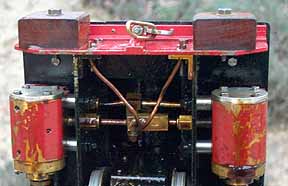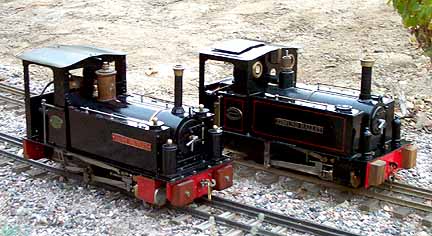
Back to Sidestreet Bannerworks
November 2002
Jack Wheldon’s “Charles Pooter”
by Marc Horovitz

Jack Wheldon (now deceased) is a near-legendary name in the annals of small-scale live steam. He was a pioneer in the development of reliable, simple to operate, robust, no-fuss locomotives for use on narrow-gauge garden railways. His "Charles Pooter" class is probably the culmination of his work and research.
In designing the Pooters, Jack wanted an engine that anyone could achieve satisfaction with -- an everyman's locomotive. He named it after Charles Pooter, a character in George and Weedon Grossmith's 1892 book, Diary of a Nobody. (If you've seen the film Topsy-Turvy, about Gilbert and Sullivan, you know who George Grossmith is.) Mr. Pooter was an average fellow who represented the common man. Jack wanted this locomotive to be for him.
Jack advertised his engines in the model press and was soon overwhelmed with orders. At this time he contacted Roundhouse Engineering about taking over the orders. I asked Roger Loxley of Roundhouse about the Wheldon-Roundhouse connection. Here is his response.
"I met Jack in 1982 when Lady Anne was first launched and he contacted me to talk about a review of the engine for one of his regular magazine articles. We quickly became good friends, as we were of like mind and both developing a similar style of meths firebox. We shared ideas on small-scale live steam and had many, many long conversations and letters on the subject. I still have a thick file of all his correspondence, and interesting reading it makes, too.
"Jack had been advertising his “Charles Pooter” locomotives in the railway press and had received about twenty orders in a very short time. Unfortunately, he could only produce them at the rate of two or three a year and felt rather awkward about the long waiting list that was quickly forming. He liked my work and we got on very well, so he asked me if I would be interested in taking over the design as a Roundhouse model. I was eager to expand my fledgling company and quickly agreed.
"I spent several weeks “productionising” his design and all the customers on his waiting list were contacted to see if they were happy with the idea. All were pleased to accept the change, especially as it meant that they would get their engines much quicker. At this point Barry Vaughan joined me at Roundhouse to cope with the sudden increase in work load.
"Pooter was introduced into the Roundhouse range in 1984 and was finally discontinued in 1990. The design went through a few minor changes over the years; e.g., changing from the original tinplate bodies to etched brass, round spectacles later became square, and the Hackworth valve gear went through a couple of redesigns.
"There were two other variations: “Mr Merlins Pooter”, produced for Tom Cooper in 1986 and 1987, and Erica, produced from 1988 to 1989. Both used the Pooter chassis/boiler with a different-style body.
"Although a good engine, the Pooters were never overly popular and only sold in relatively small numbers. The final tally would have been aproaching 200 engines. I can’t give you exact numbers, though, as we didn’t start assigning serial numbers until 1993."
The model
Only eight Pooters were built by Jack. These were all meths fired. The first four had slip-eccentric reversing while the latter ones had Jack's unusual Tayleur/Wheldon valve gear. This is a sort of divided Walschaerts. The idea was to remove the expansion link from the valve as far as possible, obviating the need for a curved link. A straight link, as is on this engine, is much easier to make and the reversing linkages are simpler, too. The engines were equipped with pot boilers and Jack's special firebox, which was designed to maximize efficiency of the fire while keeping the engine relatively cool.
My example is Daisy Mutler, named after another character in the book (whose last name was actually spelled MUTLAR) and is the fifth in the line of Pooters and the 22nd engine produced in Jack's Burbage workshops. It has standard boiler fittings, including a pressure gauge, a throttle, a safety valve, and a vacuum tap/blowdown. This latter is an interesting and useful device that is fitted to relatively few engines. It is simply a valve on the backhead or (in this case) steam turret connected to a short length of pipe. At the end of a run, a rubber tube can be fittied to the pipe and the other end placed in a reservoir of water. When the valve is opened, residual steam bubbles into the reservoir. As the boiler cools, a vacuum is created that will suck water back into the boiler, thus refilling it.
Another interesting feature is the dummy drain cocks. Exhaust steam from drain cocks on British engines is traditionally jetted toward the front of the engine. On Daisy Mutler, two tiny lines are taken off the exhaust pipe from the cylinders and routed through the front buffer beam. As the engine travels, tiny spurts of steam can be seen coming from these lines, giving an accurate illusion of open drain cocks.
The burner is a more-or-less standard alcohol burner, fed from a tank under the cab. It has a plate across the bottom to restrict air flow, which is part of the whole firebox design. This plate also hampers lighting up to a certain extent.
The run
After oiling all around and supplying the engine with its necessary fluids, I fired it up on the track. The weather was ideal for steaming -- cool and cloudy. When pressure came up, I coupled the engine to a pair of ancient Archangel coaches and a coach, now in need of restoration, that Jack had scratchbuilt for his own Border Counties Railway. I opened the regulator, gave a little push, and the train was off. The regulator handle is readily accessible and speed control is not a problem.
The train ran unattended (with the exception of three or four brief stops to add fuel) for probably 45 minutes. At this pont I extinguished the fire and refilled the boiler through the vacuum tap. This low-tech process is strangely satisfying. The fire was relit and the train departed again for another 45-minute run, pouring out clouds of steam from the stack and little puffs from the drain cocks. The exhaust beat was loud and distinct and the entire experience was everything one could hope for running a favorite engine in perfect weather. I think Jack's goals were more than realized in this exceptional locomotive.
|
|
|
| Builder | Jack Wheldon (England) |
| Date built | 1983 |
| Gauge | 32mm (gauge 0) |
| Scale | 16mm |
| Boiler | Pot |
| Fittings | Safety valve, throttle, pressure gauge, vacuum tap/blowdown |
| Fuel | Alcohol |
| Blow-off pressure | 60 psi |
| Cylinders | Two double-acting D-valve |
| Reversing gear | Tayleur/Wheldon |
| Lubricator | Displacement |
| Dimensions | Length, 10-1/4"; width, 4-1/4"; height, 6-1/4" |



Right: The cab interior. The large lubricator is at the upper right, the pressure gauge just below it. In the center is the regulator, with the vacuum tap on the left. The hole at the bottom is the filler for the meths tank.


Right: The underside of the engine is pretty conventional. A notable difference, though, is the plate across the bottom of the burner to help shield the fire.
Below left and right: The thin lines extending into the buffer beam are the steam lines that form the dummy drain cocks. In the right picture, the lines emerge unobtrusively just below the lower screws in the buffer beam.





Back to Sidestreet Bannerworks
This page and its contents Copyright Sidestreet Bannerworks, 2002